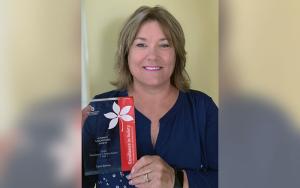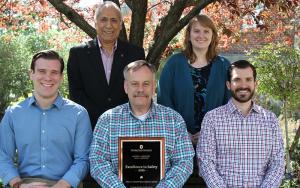The University Laboratory Safety Committee (ULSC) at The Ohio State University recognizes recipients of the fourth annual “Excellence in Safety” Award. The award recognizes three categories of those who have made a considerable contribution to improving laboratory safety on the Ohio State campus: a university faculty or staff member (Staff Award), an undergraduate or graduate student (Student Award) and a laboratory research group (Group Award). Such contributions can be defined as but are not limited to actions taken to prevent injury or illness, outstanding response and cooperation given to resolve unsafe conditions, consistent improvement during laboratory inspections, or any other consistent and proactive demonstration of efforts in support of a positive laboratory safety culture.
Congratulations to all of the 2020 award winners! Thank you for making The Ohio State University a safe working and learning environment for everyone!
Faculty/Staff Award - Carol Barnes, Facilities Manager for Biochemistry in the Department of Chemistry and Biochemistry, manages the day-to-day needs of the researchers in the department’s south campus area, ensuring laboratories are in compliance with departmental and university safety policies and guidelines, thus increasing the overall safety standards across the department. She liaises with laboratories in the north campus area, representing the south campus in discussions with the Safety Committee, Joint Safety Team, and departmental administration, always addressing challenges with a smile and a positive attitude. She serves as the safety coordinator for the 12 biochemistry research labs spread across the BioSci, Riffe, and BMRT buildings, reaching on a first-name basis approximately 150 students, faculty, and staff. During the setup of a new lab, she was the liaison with CBC researchers, principal investigators, and Environmental Health and Safety. Carol became point of contact for lab coat retrieval and exchange, allowing researchers to focus on their primary responsibilities instead of diverting their time to travel back and forth to the Chem Stores facility. She leads monthly safety inspections in the South Campus buildings, with walkthroughs aimed at ensuring compliance, identifying any potential risks or hazards, and confirming safety equipment is in good working order. Her involvement has nearly doubled PPE safety compliance. She helps researchers find strategies that will allow them to be successful in terms of implementing safe practices, ranging from helping scientists dismantle obsolete equipment that could pose a safety hazard to helping them set up record keeping for checking function of safety showers and eye washes. Carol has been involved with the student-led Joint Safety Team, participating in their meetings and helping with efforts to involve external participants to enrich the student experience. As a de facto co-advisor to the group, she spearheaded a shift for waste disposal management, among other initiatives. Carol goes above and beyond to promote the safety of the Biochemistry researchers in the department and is a model for other departments’ safety coordinators.
Student Award - As a Lab Safety Officer, Richard Hickey conducts the standard protocol, but in 2019 he took over as the leader of the chemical hygiene committee for Chemical and Biomolecular Engineering. He arranges meetings for all laboratories and facilitates faculty and staff liaising to discuss safe process design, waste disposal, and all things safety related. He is working with Environmental Health and Safety to adapt the laboratory inspection checklist that is used to maintain safety standards across all 14 wet labs in CBEC. The result will be a lightweight self-inspection form that can be used by any laboratory across campus. As a paramedic since 2009, Richard has taught CPR with the American Heart Association and the American Red Cross since 2012. Recognizing the importance of a well-trained workforce in case of emergencies, in 2019 he established the department as an authorized American Red Cross training site. As lead instructor and with assistance from the department, he brought in proper training equipment and has issued more than 30 certificates to students, faculty, and staff. Richard has been an excellent mentor for his and other labs in CBEC. His willingness to help others with safety issues and inspections has made a lasting impact on the department, and his proactive approach to safety is the gold standard for others to follow.
Group Award - Wilbur A. Gould Food Industries Center in the College of Food Agricultural and Environmental Sciences - Matt Papic, Steven Simmons, Gary Wenneker. The Center proactively developed an annual training program for teaching assistants in the Department of Food Science and Technology. It is responsible for management of two pilot food processing laboratories, where most of academic laboratory sessions take place. This group actively maintains the facility, meeting the inspection and licensing requirements of the Ohio Department of Agriculture and the U.S. Food and Drug Administration. Steven Simmons, the department’s Safety Coordinator, is a liaison with the college’s Safety and Health Coordinator. Before the current program, it was accepted that instructors or laboratory supervisors would operate all of the equipment used in the classes taught in the facility each year. Through the annual program, the teaching assistants are brought into the pilot laboratory before the semester to be trained on equipment operation, utilities, chemical safety, and personal safety. The laboratory supervisors then meet with the teaching assistants in advance of each lab session to ensure they are prepared for the class and confident in how to safely operate the equipment. This has had a significant impact on safety, increasing each teaching assistant’s equipment operation skills and applicable safety knowledge and allowing them to focus on teaching during class. For the past two years, 34 graduate and undergraduate teaching assistants directly benefitted from the training. As a result, more than 250 students safely completed laboratory coursework with zero cases of injury.



